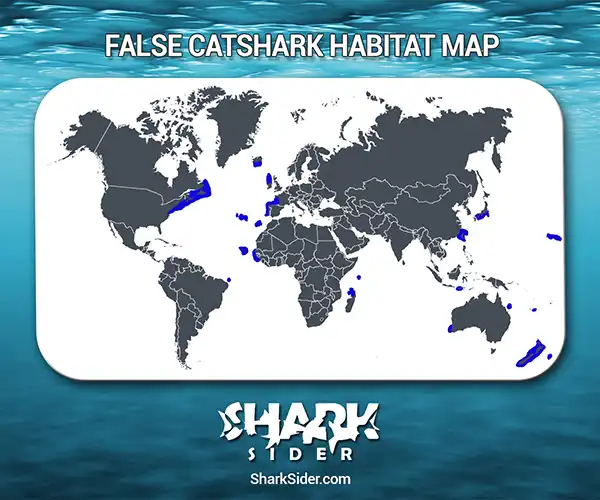The false catshark is a bulky fish with a soft and slack body. Félix de Brito Capelo, a Portuguese ichthyologist, described the species for the first time in 1868 when he found an adult male specimen of the false catshark. He noted that the fish resembled the genus Triakis, but there was no presence of a nictitating membrane (which was later confirmed to be untrue). Thus, he named the shark Pseudotriakis’ whose nearest translation from Greek means false catshark.
These ground sharks, belonging to the family Pseudotriakidae, are slow-moving predators. They also happen to be the only member of their genus.Their unpleasant and inactive appearance earned them names such as – sofa shark and dumb shark. They’re also known as the keel-dorsal shark.
False Catshark Scientific Classification |
|
| Kingdom | Animalia |
| Phylum | Chordata |
| Class | Chondrichthyes |
| Order | Carcharhiniformes |
| Family | Pseudotriakidae |
| Genus | Pseudotriakis |
| Scientific Name | Pseudotriakis microdon |
Description
False catsharks males reach a maximum size of about 8.85 ft., whereas the females can grow about 9.8 ft in length. The maximum recorded weight for these sharks is 276 lbs.
Most of them appear dark brown, though some false catsharks also have a grayish body.
The head of the false catshark is broad and consists of a short and well-rounded snout. They have a huge arched mouth with short furrows at the corners giving the shark a smiling appearance.
They have long and narrow eyes covered with an additional layer of underdeveloped skin.
Each jaw contains more than two hundred rows of narrow teeth. The teeth are arranged in straight lines in the upper jaw and diagonally in the lower jaw.
The anterior rims of their nostrils have large skin flaps. They have five pairs of small gill slits.
One of the most distinctive features of false catsharks is the presence of a long and low first dorsal fin. The second dorsal fin originates ahead of the anal fin and is considerably bigger than the first. They have small, rounded pectoral fins and a small caudal fin with a central notch close to its tip.
The dermal denticles in the body of these sharks are scanty and shaped like arrowheads..
Where do they live
Map Of The False Catshark’s Habitat

The false catshark is found globally. Its population ranges from the western Atlantic (U.S., Canada, Cuba, and Brazil) to the eastern Atlantic (Iceland, France, Portugal, Senegal, the islands of Madeira, the Azores, the Canaries, and Cape Verde). The species has also been spotted in the Indian Ocean (Australia, Madagascar, Mauritius, and Indonesia) and the Pacific Ocean (New Zealand, Taiwan, Japan, Indonesia, the Coral Sea, and the Hawaiian Islands).
These deepwater fish inhabit depths of water ranging from 1,600 and 4,600 ft. The deepest point at which the species has been recorded was 6200 ft. They reside on continental and insular slopes and swim close to the ocean floor near troughs, seamounts, and deepwater reefs.
Behavior
Dietary
The general diet of the false catshark consists of bony fishes such as grenadiers, cutthroat eels, and snake mackerel. They also feed on lantern sharks, squids, octopodes, and shrimps.
They have also been known to scavenge dead surface fishes like mackare, frigate and pufferfishes. In a rare situation, a certain specimen of false catshark captured along the Canary Island, was found to have ingested human garbage that included a whole lot of things from potatoes to plastic bags, pear to soft drink can.
Reproductory
The false catshark are viviparous, with the oophagy or egg eating observed in the developing embryos which consume the ova or egg that their mother release.
The presence of a single ovary (on their right) and two functional uteruses makes this fish capable of producing a large quantity of ova. In one case, over 20,000 ova were found in a 7.9 feet long female.
The gestation period lasts 1-3 years, in which the yolk nourishes the developing embryos. The external yolk sacs of the female are later replenished by storing the excess yolk material, which serves as reserve food post birth.
Litter size usually consists of one pup per uterus, although there have been instances of four pups in a litter. Newborns measure 3.9–4.9 ft long during birth. Male false catsharks undergo sexual maturity at body lengths of 6.6–8.5 ft, whereas females hit maturity when they are 6.9–8.2 ft long.
Adaptations
Despite its appearance as a slow-moving, inactive species, the false catshark displays sudden quick bursts of speed. It uses its large mouth to stun, capture and consume prey of larger size. A large oil-filled liver, about one-fourth of its total body weight, allows the fish to remain buoyant and hover off the ocean bottom easily.
Interactions with humans
The false catshark is not a commercially valuable species.
They are sometimes accidentally caught by trawlers and long fishing lines. Issues such as overfishing and its low reproductive rate are concerns one must address to maintain their global numbers.
The IUCN has labeled the fish as a ‘Least Concern’ species. No known conservation mechanisms are underway to conserve these false catsharks. They were listed as a ‘Data Deficient’ species under the New Zealand Threat Classification System in June 2018.
